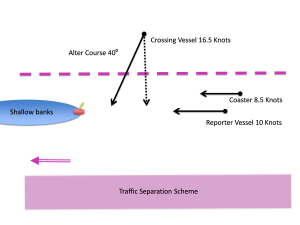The Charity
Aviation
Maritime
Close Encounter crossing a Traffic Separation Scheme (TSS)

Initial Report
A report of a near miss at a busy crossing section of a TSS: This includes an excellent response from the Third Party.
What did the reporter tell us?
Own vessel was proceeding in a lane of a Traffic Separation Scheme that was in close vicinity to a bank. A ferry was observed leaving Port A bound for Port B. Initially the closest position of approach (CPA) was 1.5 mile astern of me. At a range of about 4 miles he altered course 40 degrees to starboard, resulting in a CPA and bow crossing range of 0.2 miles. By the time the range was 3 miles, no attempt had been made to call me by VHF radio to advise his intentions. I called to ask for clarification of his intentions and was told he had altered course 40 degrees to starboard and wanted to pass ahead of me and that I was the give way vessel. I advised him that I could not alter to starboard as I was overtaking a small coaster doing about 8.5 knots and just 6 cables away on my starboard quarter; with no room to pass on the other side of the ferry due to the proximity of other vessels and transiting at a relatively slow speed.
He told me that I was the give way vessel, which is absolutely correct, and that I should slow down to let him pass ahead of me. This was at a range of 3 miles and he had made it into a close quarters situation by altering to starboard in the first place. Fortunately we were proceeding at slow speed around 10 knots and I was able to slow our ship down fairly quickly to allow a CPA and bow crossing range of 1mile.

The lessons to be learnt
The reporter said, “Expect the unexpected!” This was an ill-advised manoeuvre at very close range, creating a close quarters situation when it was totally unnecessary. If he had maintained his initial course then a close quarters situation would have been avoided. This is a passenger ferry making a very dangerous and late manoeuvre.
Third party ship manager’s response:
Obviously our ferries have to cross the TSS as near as possible to right angles. That said, we do “shape-up” to avoid clusters of ships in the TSS, and this is normally done as soon as possible after leaving Port A so the other vessels have time to assess the intention of our vessel. However, that would not allow a 40-degree alteration to starboard to cross the TSS. The relevant extract of our company regulations state “When crossing ahead of another vessel, the bow crossing distance (BCD) is to be no less than 1.5 miles at all times unless navigational circumstances, such as concentrations of heavy traffic, prevent this safety margin from being achieved. BCD is the distance of own ship from the other vessel when crossing her projected heading line. The perception of the situation from the other ship’s bridge must be considered when assessing whether to pass ahead. It will be good practice to maintain a minimum CPA of 1.5 miles when crossing ahead of another vessel, particularly if it is a fast vessel. This will require a greater BCD than 1.5 miles.” I have reviewed now the Voyage Data Recorder (VDR) of this incident. I have also asked the senior master to attend and reviewed this with him. I believe the report made from the reporter is accurate and our OOW could have made better decisions. The OOW on the ferry was faced with a number of vessels in the TSS lane and altered to starboard to head for a gap. However by doing so he:
- Gave way when he was the stand on vessel.
- Ended up crossing the TSS at an angle.
- Created another close quarters situation
- Altered into the flood tide and so lost speed over the ground.
The OOW could have stood on and gone astern of the reporter’s vessel. This would have created another close quarters situation with a SW going vessel to the south, who would have then had to slow down or alter to starboard. However, this would have been preferable to the situation created. There were other learnings from the VDR which the senior Master is taking up with the bridge team. I apologise to the reporter and we will be addressing this and ensuring wider leanings from this. The OOW is hugely experienced having worked on this route for many, many years. Again there is a learning here that experience does not guarantee good decisions.
CHIRP Suggests
An excellent report and the response from the third party is an example of best practice and is to be congratulated. Their proactive use of VDR to investigate, follow up, and then use as a training tool is most commendable.
CHIRP thought there might be commercial and tidal implications that may have influenced the decision and the need to cross the TSS close to 90 degrees. CHIRP suggested employing better use of ‘Trial Manoeuvre’ exercises and perhaps the ferry OOW should have altered course to show the vessel a “green side light” and followed around the stern of the vessel.
CHIRP has also noted Singapore has been trialling three green lights in a vertical line since 2011 and an IMO Assembly Resolution agreed that this signal could be recognised. Discussion now concerns whether to insert a requirement into Rule 10.







